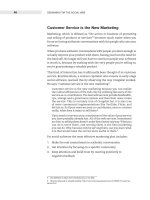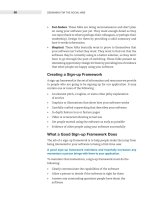designing for the social webj PHẦN 4 doc
Bạn đang xem bản rút gọn của tài liệu. Xem và tải ngay bản đầy đủ của tài liệu tại đây (7.74 MB, 20 trang )
ptg
48 DESIGNING FOR THE SOCIAL WEB
Customer Service is the New Marketing
Marketing, which is defined as “the action or business of promoting
and selling of products or services”
5
becomes much easier when you
focus on having authentic conversations with the people who use your
software.
When you have authentic conversations with people, you learn enough to
actually improve your product with them, freeing you from the need for
the hard sell. No longer will you have to convince people your software
is worth it, because by working with the very people you’re selling to,
you’re guaranteeing a valuable product.
This kind of interaction has traditionally been thought of as customer
service. Brad Burnham, a venture capitalist who invests in early-stage
social software, learned this by observing the way Craigslist worked.
He says “customer service is the new marketing”:
Customer service is the new marketing because you can realize
the radical efficiencies of the web only by enlisting the users of the
service as co-contributors. The best web services provide bandwidth,
cpu, storage and a governance system and then their users create
the service. This is certainly true of Craigslist but it is also true
of more commercial implementations like YouTube, Flickr, and
del.icio.us. So if your users are your co-contributors, your co-creators
really, what does it mean to sell them?
If you need to convince your contributors of the value of your service
you have probably already lost. All of the web services I mentioned
are free, so selling them doesn’t make literal sense anyway. What you
can do is serve them, and serving them is the best marketing
you can do. Why, because only by serving them, can you learn what
it is that would make the service more useful to them.
6
For social software the most effective marketing plan includes:
1. Make the real commitment to authentic conversation
2. Get attention by focusing on a specific community
3. Keep attention and build trust by reacting positively to
negative feedback
5 this defi nition is taken from the Dictionary on my Mac
6 Brad’s entire post is valuable reading:
servic.html
ptg
CHAPTER 3 AUTHENTIC CONVERSATIONS 49
Make the Commitment to
Authentic Conversation
Simply having a conversation doesn’t necessarily create awareness,
interest, or better software. Conversation—at least the act of initiating
it—only amplifies the existing sentiment.
In other words, if you decide to have a conversation with people about
your software and:
a. Your ser vice stinks : the resulting conversation will be about how
much it stinks.
b. Your serv ice is great : the resulting conversation will be about how
great it is.
Tip: It’s better to think of technology like blogs, forums, and
discussion boards as amplifying customer opinion rather than
improving it.
No matter what technology you use, the point is to have real conver-
sations with people. If you do start having conversations with your
audience and it turns out that your product stinks, you then have two
options. You can:
a. Listen to the feedback (positive or negative), engage with those
people, and improve your product/service.
b. Ignore the feedback, keeping your product/service the same, and
continue not improving.
Actually, there is a third choice. If you really don’t want to succeed, you
can disagree with the feedback.
Finally, if you take the first choice and choose to engage and improve,
you will start to realize a positive vibe. People will start to recognize
that you actually care. And since companies that care are so rare, your
customers will go tell their friends about it. Then you’ll have the buzz
and demand!
Making this choice is making the commitment to authentic conversation. It
is the best thing you can do for the long-term health of your software.
It is the key to the kingdom, so to speak, because when you are hav-
ing authentic conversations, you will find out everything you need to
improve over time. Authentic conversations give you a chance to show
you care.
ptg
50 DESIGNING FOR THE SOCIAL WEB
Ten Steps to Authenticity
Nobody can force you to care. But assuming that you do care, there are
some very concrete things to do that show you care.
1. Don’t wait for conversation: initiate it. Yes, create a blog, or at least
have some forum for discussion, and then create conversations. Ask
people what is important to them. Ask them what they care about
in relation to what you do.
2. Publish the real story of your company/organization. Tell people
what you believe in, how you got to be where you are, where you
hope to go. This will attract like-minded people.
3. Publish your views on privacy and support. Explain what type of
relationship you want with people.
4. Listen, internalize, and respond thoughtfully. Don’t disagree, work
together. Make it obvious you’re listening.
5. Help people learn about your software at their own pace. Provide
different levels of learning material: tutorials, manuals, help
documents.
6. Make feedback a top priority. Give people an easy way to shoot you
an email. Have a prominent contact page on your site and have
someone read the messages promptly.
7. Form a partnership with your customers. Work together to solve
their problems. Don’t just provide solutions they have to take or
leave, give them options.
8. Make authentic conversation a part of the culture. Get everyone
involved. Designers, developers, everyone. Give everybody the ability
to reach out to customers. Make authentic conversations a mandate
for all people who touch the software in any way.
9. Anticipate and act on change. Recognize that feedback is a natural
part of design, and that people who are passionate about your prod-
ucts will naturally have more feedback. They care.
10. Hire a community manager! Even better, hire someone who is already
a passionate member of the community.
ptg
CHAPTER 3 AUTHENTIC CONVERSATIONS 51
The Importance of a Community Manager
The founder of Craigslist, Craig Newmark, thinks community manage-
ment is so important that he does it himself. Of all the jobs a founder
could possibly do to run the company, Newmark focuses on the one
that seemingly anyone can do.
I figure that reasonably good customer service is part of the social
contract between producer and consumer. In general, if you’re going
to do something, you should follow through and not screw around.
As a nerd, I have the tendency to take things pretty seriously, so if I
commit to something, I try really hard to stay committed.
This isn’t altruism or social activism; it’s just giving people a break.
Pretty much all world religions tell us that one moral value is to
help other people if you can. I feel that customer service, even when
you get paid for it, is an expression of that value, an everyday form
of compassion.
7
It is easy to see from Craig’s description how integral he thinks customer
service is to the experience of people using the site.
While it’s easy to think of customer service as “dealing with the public,”
Craig has a more optimistic view of the people he deals with:
We’ve found people to be extremely trustworthy. People are over-
whelmingly good and if you trust them and seriously engage and
try your best to work with people, they’ll work with you in return.…
At Craigslist the company we just run the infrastructure and do
customer service. People respond by doing things on the site and
giving everyone else a break and that really works pretty well.
8
What Community Managers Do
Why am I talking about community management in a design book?
Here’s why: to the customer who is using your service, there is no differ-
ence between the software and support. When people use your software,
when they’re interacting with it, and they need help, they don’t expect
to get it from somewhere else. Since you, the designer, are planning the
experience they’re having, it’s up to you to make it right.
7 />8 />ptg
52 DESIGNING FOR THE SOCIAL WEB
In some cases, the managers are the designers. The designers at 37signals
describe their philosophy of feeling their customers’ pain:
At 37signals, all of our support emails are answered personally by
the people who actually build the product. Why? First off, it provides
better support for customers. They’re getting a response straight
from the brain of someone who built the app. Also, it keeps us in
touch with the people who use our products and the problems they’re
encountering. When the’re frustrated, we’re frustrated. We can say,
“I feel your pain” and actually mean it.
9
Community managers are part of the business, they are not consultants
or outside help. They need to have intimate ties with both designers and
developers, so when a difficult situation arises, they can fully explain it to
your customers.
Community Building isn’t about Features
If there were one immutable law of social software, it would be this:
Technology cannot solve people problems.
No matter how great the technology you’re using, it can’t solve what
are fundamentally human social problems. Garnering interest, getting
people excited and talking about our software: the things we really
want take real people making human-to-human contact. There is no
way around it. So forget easy technological solutions. Technology might
help you along the way, but it can’t have conversations for you and it’s
no substitute for actual human interaction.
Take, for instance, the following list of ten ways to build community
created by Heather Champ, community manager at Flickr. Notice that
not one of the ways Flickr builds community is about a feature. She
never even mentions them!
9 />ptg
CHAPTER 3 AUTHENTIC CONVERSATIONS 53
Ten Wa y s F l i c k r Build s C o m m u n i t i e s
10
1. Engage. Don’t just listen to your community
2. Enforce. Let the community help set standards and policies for appropriate behavior—
then enforce them
3. Ta ke R esp ons i bil ity. Fess up immediately when you make mistakes
4. Step Back. Don’t be afraid to step back and let your customers take over
5. Give Freely. Never underestimate the allure of a free T-shirt (or sticker, or button…)
6. Be Patient. Ta ke k nee -jer k re acti ons wit h a gra in o f s alt
7. Hire Fans. Make sure your employees are as passionate about your product as your com-
munity’s most die-hard fans
8. Stay Calm. Develop a thick skin
9. Focus. Be fl exible but don’t lose sight of your priorities
10. Be Visible. Stay human
Instead, Heather talks about human-to-human interaction: ways to take
responsibility, ways to communicate how you want the community to act.
That, not features, is what it takes to manage a community.
Get Attention by Focusing
on a Specific Community
It’s hard to imagine that many of the behemoth web sites and applica-
tions we deal with on a daily basis all started from nothing. Many of the
sites share something similar and counter-intuitive, though. They grew
large not by focusing on large audiences, but by focusing on small, specific
communities and growing from there.
10 ickr/index_01.htm
ptg
54 DESIGNING FOR THE SOCIAL WEB
. Facebook. Facebook started in the concentrated microcosm of the
Harvard University campus and then spread to other campuses
.
Amazon. The sell-everything-under-the-sun Amazon started
out by focusing principally on books
.
Flickr. Flickr grew out of photo-sharing features created for an online
game called Game Neverending
.
YouTube. YouTube started as a simple tool for friends to share
videos
.
Craigslist. Craigslist started as an email list of San Francisco events
for friends of its founder, Craig Newmark
Craig explains how he turned a small, focused list into the Craigslist of
today by simply listening to customers:
Craigslist was originally a very simple e-mail list for my friends,
focusing on arts and technology events in San Francisco. People
suggested doing more, like job and apartment listings, so I did that;
then I got more feedback—so I did even more stuff. Today, Craigslist
helps people in more than 100 cities in 24 countries with everyday
needs, like finding a place to live or getting a job or selling furniture.…
We have a pretty good culture of trust and goodwill.
11
By focusing on a very small community, you can get valuable feedback
that will help you when you want to focus on a larger community down
the road.
If Possible, Build for Yourself
There’s an interesting trend among successful web applications that
isn’t always apparent. Many successful apps are built by the same
people who use them. In other words, designers and developers build
for themselves.
There are lots of advantages to building for yourself:
. Less user research to do because you are the target user. Your use
is user research.
. You’re using it from day one. This means that you are dealing with
the core issues each and every day.
. You’re finding all t he litt le nits, quirks, and hiccups that only real
use finds. This is invaluable.
11 />ptg
CHAPTER 3 AUTHENTIC CONVERSATIONS 55
But perhaps the biggest difference of building for yourself is passion.
People who build for themselves are almost always more passionate
than folks building for someone else.
Dan Cederholm, designer of the social wine application Corkd,
12
which
allows people to share their wine experiences with others, nicely sums
up the difference:
There’s a real difference between being a hired hand on a project for
a specific amount of time and someone who has ownership as well
as passion for what they’re working on (ownership and passion can
be exclusive as well, but combined, they pack quite a punch). The
short-term, part-time attention of a freelance designer or developer
can often lead to clunky, duct-taped solutions after the contract is
over and the site is actually being used by real people. Cork’d has been
the complete opposite situation, where we’ve been able to launch a
product that would be considered “done” under most circumstances
and then react to member feedback using the same attention to
detail that went into the initial construction.
13
Build Outwards
When you build for yourself, the next logical step is to have your
friends try it out. This is not just for fun, though. This is the beginning
of spreading the goodwill about your web application. So you’ll want
to not only seed your application to your long-time friends, but you’ll
want to identify people who would be very good people to know, get
feedback from, and tell others.
Building outwards is much easier than releasing to the general public
without a solid starting point. It’s akin to planting a few small seedlings
and focusing on them instead of scattering seeds on the ground and
hoping some take root. Yes, you start off with a smaller area covered,
but what is there is healthier and already alive. Its growing, while your
far-flung seeds may or may not take.
Also, when the people helping you realize they’re part of an early proj-
ect, they’re much more likely to support you. People root for underdogs.
It’s in our nature. They don’t see it as trouble to use software that isn’t
perfect, in fact, they want to help make it perfect.
12
13 />ptg
56 DESIGNING FOR THE SOCIAL WEB
Release Early, Release Often
Eric Raymond, in the classic open-source manifesto The Cathedral and
the Bazaar, says that open-source succeeds in big part by adopting a
strategy of “release early and often.”
14
This has several effects:
. Builds goodwill
. Shows people that you’re there and improving
. Gets people coming back often
. Lets you fail fast
A major benefit of fast iteration is you also fail fast. Failing fast means
you invest less time in the things that don’t work. If you find what doesn’t
work quickly, then you quickly take action to turn it into something
that does work.
Ironically, teams that fail fast improve faster than those who try to
get everything right at every iteration. The reason is simple: Teams
trying to get everything right fail as often as everyone else does.
However, they struggle to pinpoint problems because they’ve changed
so many things.
More Experimentation, Reduced Risk
The faster you fail, the more experimentation you can do. You can try
out ideas that might not have a lot of support, but could be potential
winners. The strategy of making many small changes instead of a few
larger ones allows for an innovative environment, yet it also mitigates
risk because you can evaluate which changes have what effect and can
be confident in keeping only the positive ones.
Learn Quickly
We’ve all had the experience of sitting in meetings arguing about whether
something will work. Usually, neither side has enough data to go on, and
they end up going with their gut or with the loudest arguer, for better
or worse. Fast iteration helps solve this problem by giving developers
a platform on which they can test quickly and collect data about any
outstanding questions, instead of resorting to opinion.
14 />ptg
CHAPTER 3 AUTHENTIC CONVERSATIONS 57
Provide Continuing Interest
In addition to improving your design, fast iterations may have a psy-
chological effect on users. People who use your site with any frequency
will notice the changes, and if the good ones stick, they’ll appreciate
your ongoing efforts to improve.
The best teams not only design the changes, but design the process for
introducing the change. They experiment with methods to overcome
people’s natural resistance to change, providing migration paths and
clear benefits for each improvement.
The Building of Gmail
Paul Buchheit describes the release early, release often evolution
of Gmail:
I wrote the first version of Gmail in one day. It was not very impres-
sive. All I did was stuff my own email into the Google Groups (Usenet)
indexing engine. I sent it out to a few people for feedback, and they
said that it was somewhat useful, but it would be better if it searched
over their email instead of mine. That was version two. After I released
that people started wanting the ability to respond to email as well.
That was version three. That process went on for a couple of years
inside of Google before we released to the world.
Startups don’t have hundreds of internal users, so it’s important to
release to the world much sooner.
15
When you develop this way, releasing early and often, you build authen-
tic conversation right into the process. If you decide, before you even
build, to evolve the software based on feedback and interaction, you’re
way ahead of the game.
Keep Attention by Reacting
Positively to Negative Feedback
Every time something negative happens, you as a software maker have
a choice: do you engage or ignore? Even in the worst-case scenario,
such as the Dell Hell incident we talked about in the beginning of the
chapter, it’s probably better to engage and be authentic than to pretend
it didn’t happen.
15 />ptg
58 DESIGNING FOR THE SOCIAL WEB
The Dreamhost Debacle
The types of things that Dell went through are happening all the time
now. Just recently, the web-hosting company Dreamhost accidentally
overcharged its customers a hefty amount (seventy-five million dollars!)
and then had to deal with the public aftermath. The results were not
very good, with many folks upset at their attempt at humor, which was
to use Homer Simpson as a foil.
Figure 3.5 After Dreamhost overcharged its customers $75 million and posted about
it with a humorous image of Homer Simpson with a fat fi nger, few people found
Dreamhost’s attempt at humor funny.
But even though Dreamhost took a hard beating over their blunder and
their blog post, all was not lost. Even when things blow up, it’s important
to remember that it’s only one negative incident in what is hopefully a
long line of positive ones.
ptg
CHAPTER 3 AUTHENTIC CONVERSATIONS 59
Secret #1: It’s Over Quick
Consider this comment left by an unhappy Dreamhost customer:
Here are some awesome things I’m thankful for:
Thanks for the cheap prices.
Thanks for the awful service.
Thanks for the awful blog posts.
Thanks for the awful customer service.
Thanks for having inappropriate images on your homepage.
Thanks for causing mass headache for thousands of your customers.
Thanks for being awful enough for me to realize to switch to a real
webhost.
Thanks for making such an obvious mistake so that everyone is
alerted to your poor service.
16
The question is: how long does this person stick around? Not long. They
obviously have a mean streak, and while they were a valued customer,
they’re not being entirely fair about the issue. If people are really upset,
they’re gone quickly. Better to take it on the chin and quickly resolve to
make the situation better.
Secret #2: People are Cool with Hiccups
Surprisingly, most people are reasonable and are cool with hiccups in
your service, as long as you acknowledge them and are honest in dealing
with them. That’s where authenticity comes to your aid. It’s actually OK
to screw up as long as you’re not trying to deceive people about what
happened. The Homer Simpson reference was straddling that line.
This guy wasn’t even a Dreamhost customer, but now he puts them on
the top of the list just for responding like they did!
I’ve been working on a site for some time, and looking at different
hosts. Well this post just put you at the top of the list. No excuses,
no blameshifting, and immediately trying to fix what went wrong.
Yeah it’s a hassle for people, but from the sound of it you guys are
working hard to put everything right again. sometimes the measure
of a company isn’t in how many mistakes you find, but how they
handle them when they are found. Kudos
16 />ptg
60 DESIGNING FOR THE SOCIAL WEB
Secret #3: It’s the Average that Matters
Another secret is that, like most human relationships, it’s the average
over time that matters. If you have built strong relationships with your
customers in the past, you probably have them on your side. So even
if trolls come through and try to tear your reputation to shreds over a
single incident, other people will come to your defense. Consider this
Dreamhost customer’s response to the comments:
As a dreamhost customer, I think they have been/are doing a good
job. Circumstances like this have to be foreseen, and like mentioned
before, you have to have a fallback plan ALWAYS. You shouldn’t have
everything hinging on one solution, thats bad business practice.
Besides, with Dreamhost youre probably saving/have saved much
more than you lost through this, had you going with another pro-
vider. A mistake is a mistake, time to correct it and move on. Any
other host would charge you 10x to begin with, before the error, and
wouldnt be as willing to be frank about it, detailing exactly what
happened and how. I say keep up the good work Dreamhost, and
im glad to be a customer+will continue to be.
17
17 />How To Say You’re Sorry
When you do need to say you’re sorry, it’s helpful to have a plan.
The site perfectapology.com can help with this.
Here is their template for doing so.
1. a detailed account of the situation
2. acknowledgement of the hurt or damage done
3. taking responsibility for the situation
4. recognition of your role in the event
5. a statement of regret
6. asking for forgiveness
7. a promise that it won’t happen again
8. a form of restitution whenever possible
ptg
CHAPTER 3 AUTHENTIC CONVERSATIONS 61
The JetBlue Apology
Perfectapology.com’s perfect apology hall of fame includes the following
apology
18
from JetBlue CEO David Neeleman, who bit the bullet after a
winter storm caused massive confusion and cancellations for JetBlue
customers. They’ve annotated the apology to show just what technique
JetBlue used to make such an effective apology.
Dear JetBlue Customers
We are sorry and embarrassed. But most of all, we are
deeply sorry.
Last week was the worst operational week in JetBlue’s
seven year history. Following the severe winter ice
storm in the Northeast, we subjected our customers to
unacceptable delays, flight cancellations, lost baggage,
and other major inconveniences. The storm disrupted
the movement of aircraft, and, more importantly,
disrupted the movement of JetBlue’s pilot and inflight
crewmembers who were depending on those planes to
get them to the airports where they were scheduled to
serve you. With the busy President’s Day weekend upon
us, rebooking opportunities were scarce and hold times
at 1-800-JETBLUE were unacceptably long or not even
available, further hindering our recovery efforts.
Words cannot express how truly sorry we are for the
anxiety, frustration and inconvenience that we caused.
This is especially saddening because JetBlue was
founded on the promise of bringing humanity back to
air travel and making the experience of flying happier
and easier for everyone who chooses to fly with us. We
know we failed to deliver on this promise last week.
We are committed to you, our valued customers, and
are taking immediate corrective steps to regain your
confidence in us. We have begun putting a comprehen-
sive plan in place to provide better and more timely
information to you, more tools and resources for our
crewmembers and improved procedures for handling
operational difficulties in the future. We are confident,
as a result of these actions, that JetBlue will emerge as
a more reliable and even more customer responsive
airline than ever before.
continues on next page
18 />Salutation
This short statement at the top of the page
expresses humility and remorse. It also sets
the tone in this sample apology letter.
This paragraph gives a specifi c and detailed
account of the incident and takes full
responsibility for the situation.
It is worth noting that although the catalyst
was a winter storm that NO blame is placed
on it—full responsibility is taken by the
company.
Here, we see that they recognize their role in
the situation and acknowledge the hurt and
damage done.
This paragraph details their commitment to
change and shows customers the preventive
measures being taken to ensure that this
type of situation will not happen again.
JetBlue also understands the Art of
Apologizing by providing a link on their
website to a video message from the
CEO and author of the letter. This unique
approach is what makes this a perfect
sample apology letter.
The company now offers the recipients of the
letter a form of restitution and compensation.
This cleverly crafted commitment to change
(through a Customer Bill of Rights) will shed
a positive light on the company from both
existing and future customers and the public
at large.
ptg
62 DESIGNING FOR THE SOCIAL WEB
Most importantly, we have published the JetBlue Airways Customer
Bill of Rights—our official commitment to you of how we will
handle operational interruptions going forward—including details
of compensation. I have a video message to share with you about
this industry leading action.
You deserved better—a lot better—from us last week. Nothing is
more important than regaining your trust and all of us here hope
you will give us the opportunity to welcome you onboard again soon
and provide you the positive JetBlue Experience you have come to
expect from us.
Sincerely,
David Neeleman
Founder and CEO
JetBlue Airways
19
Treat Criticism as Opportunity
It is impossible to avoid negative criticism. Better to use it to your advan-
tage and treat it as free suggestions for improvement, even if it is a bitter
pill to swallow. You can’t be perfect all the time, but you can show people
you care all the time. JetBlue came out of their situation badly bruised,
but this apology certainly helped them get back on their feet.
Dell is Well
I started this chapter by exploring the infamous Dell Hell case, where
Jeff Jarvis posted his frustration with the company and the resulting
aftermath where Dell showed precisely what not to do in those cir-
cumstances.
Well, Dell eventually recognized their mistake and took action to remedy
it. They started several new customer support initiatives founded on the
idea of having authentic conversations with their customers.
The new initiatives are paying off. Take, for example, the wonderful
blog post made by Lionel Menchaca, Dell’s Chief Blogger, after Dell’s
legal counsel asked the Consumerist blog to remove a post by a former
Dell employee with information about how pricing works on the Dell
web site. Like their decision to stay out of the Dell Hell situation, their
decision to get in the middle of this was the wrong move. Here, Lionel
apologizes authentically, and even references even references Jeff Jarvis
in his post:
19 Original JetBlue apology analysis: />Note how this is the fi rst
and only time in the letter
where they use the word “I”
as opposed to “we.” This
underscores the personal
connection that the founder
and CEO of the company is
trying to establish with his
customers.
This statement expresses
regret and lets customers
know that the company
is hoping to continue the
relationship.
Note how the last
paragraph is “You”
focused. They “humbly”
give the customer back all
the power.
ptg
CHAPTER 3 AUTHENTIC CONVERSATIONS 63
Now’s not the time to mince words, so let me just say it we blew it.
I’m referring to a recent blog post from an ex-Dell kiosk employee
that received more attention after the Consumerist blogged about
it, and even more still after we asked them to remove it.
In this case, I agree with what Jeff Jarvis had to say: instead of try-
ing to control information that was made public, we should have
simply corrected anything that was inaccurate. We didn’t do that,
and now we’re paying for it.
I believe in the customer voice—that’s why I signed up for this job in
the first place. There’s simply no cheating the system. When we’re
on the right track, folks tend to say some good things about us (or at
least give us a second chance). When we mess up, they let us know
quickly and vocally.
20
Caveat Venditor
Not long after the Dell Hell situation started, Jeff Jarvis began to realize
that his situation was a sign of things to come. He realized that he was
in the middle of a profound change brought about by the web. People
were able to band together and talk to each other, whether or not the
company was listening. And in their confederacy, they were making
actual changes in the marketplace. After hundreds of comments and
news stories about his situation and its aftermath, he writes:
The age of caveat emptor is over.
Now the time has come when it’s the seller who must beware.
Caveat venditor.
A company can no longer get away with consistently offering shoddy
products or service or ignoring customers’ concerns and needs.
For now the customers can talk back where they can be heard.
Those customers can gang up and share what they know and give
their complaints volume. Of course, they can use their reviews
and complaints to have a big impact on a company’s reputation
and business.
Public relations has to take on a new meaning. It can no longer be
about the press and publicity, which just separate companies from
the public they are supposed to serve.
Public relations must be about a new relationship with the public,
with the public in charge.
21
20 />21 />ptg
64 DESIGNING FOR THE SOCIAL WEB
Conclusion
By making a solid commitment to authentic conversations and focusing
on a specific community, you can connect as early as possible with the
people who use your software. This is the most powerful way to spread
the word about your service or product, to get people over the awareness
hurdle, and ultimately make people happy to use your software.
By reacting positively to negative situations, you can treat even the most
public of problems as an opportunity for improvement. With people
becoming publishers in their own right like Jeff Jarvis, it’s crucial to
engage rather than avoid. To the people who use your software, customer
service is vital and as much a part of the overall experience as any other
part of the design. And it’s a powerful tool to keep their attention.
The results of this unconventional marketing plan is that as people
start to get interested in your software they tell others about it. They
spread the word. Then you’ll be lucky enough to have more problems
on your hands. In the following chapters we talk about some of those
nice-to-have problems.
ptg
65
4
Design for Sign-up
How to motivate people to
sign up for your web app
If you want to build a ship, don’t drum up the men to gather
wood, divide the work and give orders. Instead, teach them to
yearn for the vast and endless sea.”
— Antoine de Saint-Exupery
In a theoretically perfect world, the people who try your software for the
first time have unlimited time on their hands: they hear about your web
application, they go and find out more about it, and, discovering how
valuable it is, they sign up for the service immediately. They appreciate
the time and energy you’ve put into your work. The end result is a real,
valuable connection between the maker and user.
In practice, however, we’ve got about eight seconds to make that
connection.
Yep, we’ve got only the tiniest fraction of time to have the most impor-
tant conversation of all: why someone should use our software. Of all
the moments of interaction, this is the most important one, because
it is when a person decides to start a relationship with you. It’s the
moment of decision, when someone answers the question: is this soft-
ware worth my time?
“
ptg
66 DESIGNING FOR THE SOCIAL WEB
What Are They Thinking?
Given how important this moment is, it’s surprising how often what we
imagine people are thinking differs from what they’re actually thinking.
Here’s a typical disconnect:
Figure 4.1 The difference between what we hope people are thinking and what they are
actually thinking is all too often quite large.
Ok, this is a slight exaggeration (but only slight). Our imagination is so
powerful that we imbue our audience with the characteristics we want
them to have: confidence, decisiveness, and passion. We want them to
be really excited by our software. But, realistically, they’re probably not.
Most likely, even people who are interested in our software still have to
be convinced before taking the plunge.
The Sign-up Hurdle
Once you have people interested, the next major challenge is to con-
vince those interested people to actually sign up to use your software
for the first time.
Figure 4.2 The hurdle of sign-up
separates those interested in your
software from those using it. This
transition is marked by lots of
questions and a need to clearly
explain the benefi ts of use.
Interested First-time use
huh?…what is this?…what does it do?…
is it worth my time?
Will it be a valuable piece of software worth
switching to? Will I have to change what I
currently do to use it?
Does anybody I know use it? Do they like it?
Oh my God! I love this software! This is
exactly what I’ve been waiting for my whole
life! Quick, sign me up for the lifetime plan!
I’m going to invite every single person I
know to sign up as well. My life is fi nally
complete!
What we imagine people are thinking
(all smiles, confi dent, decisive, passionate)
A more realistic scenario
(furrowed brow, unsure, indecisive, frustrated)
ptg
CHAPTER 4 DESIGN FOR SIGN-UP 67
The importance of this step cannot be understated. It is crucial for
several reasons:
.
The first, and lasting, impression. The first impression someone has
of your software is your best chance to start a person down the road
of becoming a loyal user. If you lose someone in this initial transac-
tion, they’re very unlikely to return, having convinced themselves
that your application isn’t worth using.
. All questions, few answers. At this stage people have the most
questions of all, and in answering those questions you can use the
the opportunity to tell the story of your software.
. Potential to kinetic energy. At this stage people are getting ready to
take their first actual steps in using your software. It’s a big deal to
change from the potential energy of being interested in software to
the kinetic energy of actually using it.
. Critical choice. If you make a living through your web application
(and many of us do), the choice people are making of whether or
not to use your software is anything but trivial. They’re choosing
to either start a relationship with you or have it with someone else.
This will undoubtedly affect your future in a big way. Therefore, it
is serious business.
Different Strokes for Different Folks
Each person who visits your web application has their own agenda:
they’re trying to do something specific. While we don’t always know
what that something is, we can identify recurring roles that seem to
crop up again and again. Here are some roles to watch out for:
. Ready to Go. This is the role most people design for. This is the role
we hope for. These people are ready to start using your application.
The key to designing for them is to get out of their way. They’re
already convinced your software is worth trying, so make it as
easy as possible to sign up by eliminating usability problems and
unnecessary friction in the interface.
.
Interested but Unsure. These people are interested in your software
but are unsure if it is for them. There are a lot of these people. They
need to be reassured they’re making the right decision in trying your
software. They have specific questions about what your software
can do. The key to designing for them is to provide multiple levels of
detail (see section below) so that they can find appropriate answers
to their questions.









